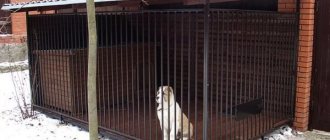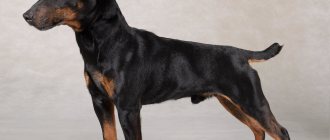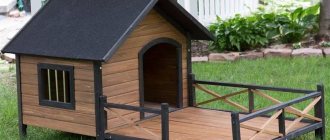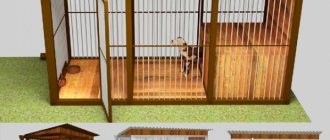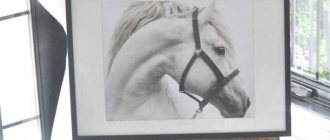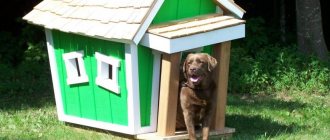The common phrase about a dog's life these days only applies to stray dogs. Watchdogs were never deprived of the attention of their owners. They are ready to spend a lot of money for their pets, providing them with comfortable housing.
Not everyone would agree to keep a short dog acting as a barking “alarm” to guard their home. Another thing is the Eastern European or German Shepherd. This is a strong and intelligent dog, well adapted by nature to life outside a warm room.
With just her appearance, she inspires respect and discourages the desire to invade someone else's territory.
Despite the warm undercoat and dense hair, it is not easy for the brave dog to serve on frosty nights. Therefore, the most important task that its owner needs to solve is the construction of a warm booth.
Our article will help shepherd owners in this matter. In it we will look at successful examples of dog houses, and also give useful recommendations on their size and arrangement.
Maintenance in the cold season
Our climate is characterized by low average daily temperatures most of the year and severe frosts in the winter months.
The German Shepherd is well protected from short-term exposure to cold, humidity and wind by its thick coat. But if kept outdoors constantly during the autumn-winter season, the animal can get hypothermia, leading to various diseases, as well as frostbite on the paws and ears. To reliably protect your German Shepherd from the cold, you will need an insulated booth. The kennel room is heated by the animal’s body, so you just need to create conditions under which the temperature will be maintained as long as possible. To do this, wooden walls are made double, and a layer of thermal insulation is laid between them. Conventional building insulation - mineral wool or polystyrene foam - is suitable. For the same purpose, a second floor is made under the roof structure - the ceiling, and thermal insulation is also laid on it.
Option for a shepherd doghouse with a vestibule
The vestibule, which is an additional air barrier that separates the warm sleeping compartment from the cold street, will help to retain heat.
The entrance hole from the street and the internal one from the vestibule must be closed with a curtain made of thick material or tarpaulin. This will help protect the dog from sharp gusts of wind and eliminate the danger of heat blowing out of the kennel.
To retain heat, the booth must be raised above the ground
Proper care
A wooden doghouse for a German Shepherd can last up to twenty years, but it should be remembered that the building requires regular cleaning and disinfection. These procedures should be carried out at least twice a year. To do this, the animal is removed from the kennel, the walls are cleaned with mild household chemicals, disinfected and treated with insect repellents. After thorough drying, the wood is, if necessary, re-coated with protective impregnations. When the walls are completely dry, the shepherd dog can return to its place.
How to set up a dog house
After creating the main frame, you need to take care of arranging the pet’s house. Strictly following the recommendations of specialists will increase the service life of housing and increase its comfort. Completion of finishing work can be carried out after assembling the main part and installing the roof, or after moving the booth to a permanent location.
Sheathing a dog house
The material used for external protection must show high resistance to temperature changes and precipitation. At the same time, he is required to have safety and standard environmental performance indicators so as not to harm the health of the pet. Professional dog handlers advise carrying out the external cladding of houses by:
- Block house. It is easy to install, visually resembles wood, and shows high resistance to mechanical damage and precipitation. With its help, the house is additionally insulated and does not suffer from airtightness. The disadvantages of the application include the need for regular painting with specialized compounds, which leads to increased material costs.
- Wooden lining. It allows you to decorate the building at the request of the owner. The smell of wood repels parasitic insects, and the lining itself is characterized by increased durability. The disadvantages of use include additional costs for treatment with an antiseptic solution, the likelihood of deformation of the home under the influence of adverse weather conditions.
- PVC lining. Its advantages are considered to be the ability to easily withstand temperature changes (from +50 to -50 degrees), the absence of changes in the primary color during prolonged exposure to the sun, and ease of installation and operation. PVC does not require additional antiseptic treatment. The list of negative qualities includes a low level of strength and lack of air circulation. The insulating layer placed between the walls begins to rot over time.
Arrangement and insulation of the house
You can build a good home with additional insulation according to the following scheme:
- Using the template, cut out two pieces from glassine.
- One part is placed on a wooden blank and secured with a stapler.
- A piece of polystyrene foam is placed on top and covered with a piece of glassine.
Important! Insulation work is completed by coating a layer of lining or plywood with an anti-rotting agent. Insulated option
How to insulate from the inside
Internal insulation is carried out according to the following scheme:
- After measuring the inner walls of the booth, a felt sheet is cut out. It must be larger in size than the wooden base by 3-5 cm on each side.
- The felt is secured using self-tapping screws (20-30 mm) and metal washers. They are screwed directly into the walls, observing a fastening pitch of 20 cm.
- After insulating one wall, move on to the next. All actions are carried out in a similar way. They also improve the upper part - the ceiling.
Important! With the arrival of spring, additional thermal insulation is removed. After this, you should dry and disinfect the home.
Does a German Shepherd need a chain?
It is recommended to keep the dog on a leash for a short time in case the pet needs to be isolated. It is extremely undesirable to do this for a long time - he will become embittered, stop trusting the owner and become vindictive.
The dog on the chain gets angry
Is it possible to keep a German Shepherd outside in winter?
The climatic conditions of our country are characterized by low temperatures for most of the year, and with the arrival of winter severe frosts begin. Animals are well protected by their fur from short-term exposure to cold, gusty winds or high humidity. Constantly being kept outdoors can cause hypothermia, frostbite in the ears or paws. To protect your pet, he needs a reliable and well-insulated kennel.
The house is heated by body heat and requires the creation of conditions under which the optimal temperature will be maintained for a long time. To do this, its walls are made double, and a heat-insulating layer is laid between them. You can use mineral wool or expanded polystyrene as it. In order to retain heat as much as possible, the roof structure is also improved by double covering with an insulating layer.
Important! Maintaining the optimal temperature is more difficult if the house is installed directly on the ground. Under it you need to make a base that raises the structure 15 cm from the ground, or install special legs.
We build the frame
- Before erecting the frame, we clear and, if necessary, level the site for construction.
- Next we assemble the base. We make the perimeter of the base from beams fastened with self-tapping screws; we strengthen the perimeter with boards that serve as the floor.
- We install vertical racks from beams. To securely fasten the racks, we connect them to the base with metal corners. We fasten the rack beams on top with crossbars along the entire perimeter. As a result, we get the main frame.
- To add rigidity to the structure, you can make additional crossbars in the middle of the racks.
House for a guard: dimensions of a booth for a German shepherd and drawings
Taking into account accepted breed standards, the dimensions of the structure should be 80x70x70 cm, with the height indicated at the lowest point - if a gable roof is planned, its ridge should be located at a height of 100...110 cm. Since some dogs prefer more spacious homes, we offer a drawing of a dog house with dimensions (width x length x height) 800x1200x850 cm.
This is what the finished and painted “house” will look like.
Below is a diagram of the structure and a table with the dimensions of the parts.
| Detail number | Part name | Material | Size, mm | Quantity | Length, mm |
| 1 | Floor frame | timber | 50x50 | 3 | 1200 |
| 2 | Flooring | Board | 150x25 | 8 | 780 |
| 3 | Horizontal front and rear wall supports | timber | 50x50 | 4 | 780 |
| 4 | Front and rear wall posts | timber | 50x50 | 8 | 350 |
| 5 | Rafter supports | timber | 50x50 | 2 | 1100 |
| 6 | Side walls | Plywood or chipboard, OSB | 9 | 2 | Cut to frame size |
| 7 | Rafters | timber | 50x50 | 6 | 550 |
| 8 | Front and rear facade | Plywood or chipboard, OSB | 9 | 2 | Cut to frame size |
| 9 | Roof boards | Board | 150x25 | 10 | 1500 |
For ease of cutting, one of the options for laying out plywood parts and an approximate assembly drawing are proposed.
Dimensions in brackets are in millimeters
Assembly order:
- The flooring is assembled on three joists (the base of the floor). The logs must be evenly distributed;
- The frame of the front and rear facade is attached to the flooring - horizontal supports and racks and rafter supports. Be sure to check whether the distance between the additional front posts corresponds to the size of the manhole;
- side and front walls are mounted;
- The roof is being laid. The boards are attached starting from the bottom, providing a roof overhang of at least 5 cm on the sides and 5...8 cm in front and behind. The overlap of the boards is 2...3 cm. It is better to protect the ridge with a special metal element (ridge additional element);
- a manhole hole is cut out. This operation can be done before attaching the front wall of the kennel.
Such a do-it-yourself shepherd dog house can be painted with any odorless paint (preferably acrylic-based) or varnished with similar characteristics. The ends of plywood parts (OSB, chipboard, fiberboard) are processed twice to avoid delamination of the material.
Project selection
A dog house can be as simple as a rectangular wooden box; such buildings are quite easy to maintain. Often the booth is a more complex structure, sometimes it is made in the same style as the main house on the site. On the Internet you can find a project for every taste, you can also develop a design and make a doghouse for a shepherd dog with your own hands. If you are in doubt which building will be convenient for the dog, it is better to show the options you like to the breeder.
Shed with additional storage space
To increase the comfort of the animal’s living conditions, it is better to immediately think about various useful elements. The kennel design may include a high feeder, a drinking bowl, a canopy, a box for toys and other accessories, and a place for a toilet. The drop-down gable roof is also great for storing additional accessories. If you include all these details in the diagram at the initial stage, the final construction will be more convenient and will look neater.
Aviary
The fact that our heroes are able to spend the winter outside the house does not mean that they can be left without a roof over their heads. Since our animal is quite large in size, it needs to be covered periodically, especially if you have guests.
Choosing a suitable house for a pet will not be so easy, because the market is ready to offer a wide variety of designs, models, materials for construction, coating methods, and other things.
First, let's look at the classification of structures:
- open,
- closed,
- mixed type.
When we talk about open structures, we mean that all the walls are made of lattice, wire, or some other visible option. It is possible that the roof is also made of the same material. The closed type involves the construction of walls made of wood, iron sheets and even bricks. Mixed methods offer you several visible walls, the rest closed, as well as a reliable, waterproof flooring.
When choosing what to build from, you should take into account several factors, such as financial capabilities, material suitable for the overall interior of the site, allergic intolerance of the animal, as well as reliability, strength and durability. Iron structures will be more expensive, but stronger and more reliable. Wooden structures are the cheapest and most common. It is natural and will not cause any bodily reaction in a living organism. Wood is always relevant and always beautiful. Indoors, the finishing is never treated with chemicals or painted. The most interesting models offer the use of several types of materials at once. For example, the frame is made entirely of metal, and the cladding is made of wood.
The choice should be taken very seriously. Each wood undergoes special processing.
Make sure no harmful chemicals are used. You should also check the smoothness of the boards. There should be no knots or splinters, cracks or breaks.
Preference is always given to coniferous species. Make sure that the boards have been treated for moisture resistance and against harmful parasites. This treatment guarantees a longer service life.
The floor is usually poured concrete. This choice is made for ease of cleaning the enclosure. It is advisable to tilt towards the façade. In this way, you can clean it by watering it with a hose, and the water along with the debris will flow out of the structure, where it is easier to remove it. There are other flooring options, such as planks.
When constructing a roof, you can choose any design, but be sure to make a slope (one or two) so that precipitation does not accumulate.
When choosing a covering, you should take into account your pet's sensitive hearing. To avoid further injury to the animal, soft tiles are best suited. It will absorb the sound of rain. According to all the rules, the door opens inward. Self-tapping screws are better for fastening, but avoid nails.
Necessary materials
For future construction, preference should be given to natural materials. The ideal option is edged boards from coniferous trees. Someone coats the boards with paint to protect the booth from moisture. But it's best to use as little chemicals as possible.
Cement particle board can be chosen as an alternative to edged boards. It will not harm your pet's health and is easy to use.
For the layer between the walls, it is better to choose polystyrene foam, since natural insulation (sawdust, fabric, felt) can serve as a “breeding ground” for various small insects.
Features of a street booth
The kennel of a dog living on the street must have the following characteristics:
- strength;
- wind protection;
- waterproof;
- thermal insulation;
- proper sizes.
Particular attention is paid to insulation. Foam plastic, mineral wool, cardboard, expanded polystyrene are used for thermal insulation.
Remember that most dogs enjoy chewing on the walls of their own home. The insulation layer is insulated by sheathing made of boards, plywood or OSB.
The structure of properly insulated walls is as follows:
- the first layer is the outer, weather-resistant skin;
- the second layer is insulation, tightly laid without cracks or gaps. Expanded polystyrene and polystyrene foam are laid on the sheathing, and a vapor barrier material (isospan, isolon, polyethylene film) is laid under the mineral wool;
- the third layer is the inner lining made of wood and plywood. The material must be environmentally friendly and breathable.
The most common booth design is a wooden house with a single or gable roof.
Location of the kennel in the yard:
- the kennel is placed in the shade;
- the watchdog must be provided with an overview of the yard;
- the booth should not be flooded when it rains. Water should also not get in from the roofs of buildings or from drainpipes.
With a gable roof
In making a doghouse for a German Shepherd with your own hands, the drawings will provide an invaluable service. A gable roof can perhaps be called a traditional option. The walls are made of wood, frame, brick. The roof is covered with wooden panels or slate. In cold areas, the structure is complemented by an attic floor made of plywood or boards, which is done to minimize heat loss.
Under the gable roof there is a storage room where you can store ammunition, toys, and training equipment. One of the roof slopes is attached to the door hinges and can be raised if necessary. The tilt angle is 50-60°, it is recommended to make the angle between the slopes approximately 40°, this is more aesthetically pleasing.
With a pitched roof
In terms of properties, this option is practically no different from the previous one, but it is easier to manufacture. The material used is the same as for the manufacture of a gable roof - tightly knit wooden panels, slate. Avoid using corrugated sheets or metal tiles, as iron becomes hot in the summer and does not retain heat in the winter.
The ramp is directed in the direction opposite to the entrance, so that during rain, water does not flow into the kennel. The tilt angle is no less than 5-10°. The wooden roof is additionally protected with slate, roofing felt, and thick polyethylene film.
Kennel with canopy
Such a shelter protects well from rain, but not from wind, which is why such a kennel is installed, as a rule, in a windproof area of the yard. The bottom and roof are made protruding from the side of the manhole. Depending on the breed of the dog, the size of the porch is selected, and this element is designed so that an adult dog can comfortably fit on it while lying down. Typically, the veranda occupies half or slightly less than the total area of the entire structure.
Booth with door
Usually the role of a door is played by an ordinary curtain. It is made according to the size of the hole, but with an overlap. The curtain is attached to the upper edge of the opening with a wooden plank and screwed with self-tapping screws. It is recommended to use the following manufacturing materials:
- tarpaulin;
- burlap folded in several layers;
- old carpets and rugs, flannelette blankets;
- dense fabric, for example, a piece of a worn drape coat;
- special silicone sheets sold in pet stores.
Young animals often tear the curtain. Wooden doors are also made, but only in regions with a harsh climate, or in case the four-legged animal reacts too violently to guests. If it is periodically necessary to lock the animal, the door is hung on strong hinges and equipped with a deadbolt or a locking hook.
Decorating a dog's house
We line the outside of the booth wall with pine boards, and use chipboard sheets on the inside.
If there are sub-zero temperatures in the region, we lay insulation between the boards and the chipboard.
Between the roof and the main space of the booth we sew a sheet of chipboard over the entire area. Then you can further insulate the booth using a layer of insulation between the sheet and the roof. We cover the roof with clapboard, cover it with roofing felt and slate.
Examples of shepherd dog kennels
As they say, theory is good, but practice is better. Therefore, we invite you to consider several interesting options for kennels for keeping shepherd dogs.
By lengthening one of the roof slopes and extending the sheathing of the booth, we will get a vestibule open on both sides. In inclement weather it will protect the dog from rain, and on a hot sunny day it will protect it from the scorching sun.
In the next photo we see an example of a booth with a gable roof, forming a vestibule open on three sides. This configuration is not only convenient for the dog, but also easy to implement.
Good visibility and protection from the vagaries of weather are obvious advantages of this design. The outside of the kennel is lined with tongue and groove boards. OSB board was used for the internal cladding of the walls, floor and roof. Roofing material – soft tiles.
The functionality of a dog house is an important, but not the only issue that should be given attention.
The appearance of the booth is also important. One of the original options is imitation of human habitation
One of the original options is an imitation of human habitation.
Having built such “mansions” for your four-legged friend with a canopy and a fence, you can proudly say that your dog lives no worse than his owner.
It is better to build a warm booth taking into account the dimensions of an adult dog. Shepherds grow quickly. Before you know it, your teenage puppy won't be able to fit into his old kennel.
The photo below shows a booth with a combined roof. Above the sleeping area it is made of a pitched roof, and there is a canopy over the entrance. This solution allows you to do without a vestibule, provided that the width of the canopy is at least 70 cm.
There are different opinions regarding the placement of the manhole. Some shepherd owners claim that it is better to do it on the narrow side of the booth. Others believe that it is more comfortable for the dog when the entrance is located on a long wall. We think that this issue is not fundamental. It is much more important to make the kennel such that the dog does not freeze in it, can turn freely, stand up to its full height and curl up for the night.
We have already said that the kennel should not be very large. Now let's look at the photo where the owner clearly overdid it with its size. If an area of 4 m2 is acceptable for a covered vestibule, then you should not make a huge shelter for overnight stays. The only exception is keeping a dog with puppies while they are growing up.
Few owners think about what height is best to place dog feeders. Practice has shown that placing them on the floor is not the best option. Therefore, today you can find booths equipped with stands for feeders.
To avoid direct contact with the ground, the floor of the booth and vestibule must be raised above the ground. A gap of 5-7 centimeters will be enough.
There should be no flat roof on the kennel. Water will always find a hole and wet your watchman.
The flat folding roof can only be used in an aviary. It is built when the house is often visited by people unfamiliar to the dog.
To prevent the dog from spinning underfoot and interfering with cleaning, a piece of plywood is placed above the entrance to the kennel. It slides up and down along two guides.
Construction requirements
The main rule is convenience and functionality. In a complex design, it will be inconvenient for a pet to move, and a large one will not fit well into a small area of an ordinary private house. It is better to give preference to simple but reliable buildings.
Types of booths for large dogs
There are several building options:
- Aviary. The house is complemented by a fenced area. The fence allows the dog to move freely, but does not allow it to leave the area.
- Gable. It has an acute angle on the roof due to the structure of the roof. This design allows water and melted snow to drain, which extends the life of the structure and increases its level of wear resistance.
- Single-pitch. The roof is installed at a slight angle, which prevents the inside of the house from getting wet. The animal can use it as an observation point.
- Tambour. Helps keep you warm thanks to the second compartment. It prevents the penetration of cold air and rain into the room.
Important! Breeding requires an option with a spacious enclosure. It will provide the bitch and her babies with comfortable and safe conditions.
Option with an aviary
What should the booth be like?
Alabais are kept outdoors all year round. The optimal choice of material for constructing a dog kennel is wood. It is able to perfectly maintain temperature and a comfortable microclimate in the summer heat. For these and other reasons, wooden booths are built for Alabais. There are several main types of buildings for such dogs:
- Insulated. When choosing any material for building a kennel, it must be properly insulated. For this, a popular material among builders is usually used - polystyrene foam. Along with it, the choice often falls on mineral wool and sawdust. If mineral wool is used for insulation, the dog must be reliably protected from this material. If mineral wool is swallowed, a dog's digestive and respiratory systems may be damaged. In winter, hay bales are placed on the booth. The kennel opening is curtained with thick fabric to prevent heat loss.
- Dry booth. Such structures rise above the ground. This technique allows you to avoid high humidity in the kennel. When making a booth yourself, you should check it for the presence of various holes and cracks. If the booth is ventilated, no insulation can protect the dog from cold drafts.
- With removable roof. When building the right booth for the Alabai, you should think about creating a removable roof. The kennel will be accessible to the dog owner. Through the roof, the booth is cleaned daily. The roof must have a slope towards the rear wall. This will prevent water retention on the roof during rainfall.
Alabais are dogs that love open spaces. They love to watch the territory entrusted to them. Therefore, the booth should be located on a hill. From his kennel, the dog will view the entire protected area.
Stages of construction work
In order to build a good kennel in which the dog will be comfortable, it is not necessary to have special skills. But the process must be taken seriously.
Stages of booth construction:
- Make a drawing of the booth, taking into account all dimensions.
- Prepare materials for the frame and roof, as well as insulation.
- Before work, it is advisable to impregnate the wood with antibacterial agents.
- It is best to make a screed for the base of the booth, but you can also lay it out of brick.
- Assembling the frame of the room from wood.
- The flooring is made of two layers of boards with insulation between them.
- It is necessary to make a low threshold between the entrance and the floor, which will protect the room from water leakage.
- When covering, do not forget to lay insulation.
- When making a roof, insulation is also necessary.
- For additional insulation in winter, it is advisable to attach a canvas curtain to the hole.
- After completing the assembly of the frame, it is coated with a special varnish.
A comfortable and functional dog kennel, made from natural materials, will delight the dog and its owner for many years.
Design options
They are selected depending on several important factors:
- number of dogs - for a couple or a female with puppies, of course, more space will be required than for one watchdog;
- breeds - herding, mountain dogs are much less sensitive to cold than smooth-haired and short-haired dogs, so the degree of insulation of the building will vary greatly;
- conditions for keeping the pet. If he freely “walks around the territory”, then the house may be smaller than for a dog sitting on a chain;
- weather conditions. In a rainy climate, a security guard will need a roof over his head in any case, even if there is no severe cold. For very hot climates, lattice or canopy-style dwellings are suitable.
In addition, booths are distinguished by the materials used. Most often they are built from wood and wood-based materials, including frames. However, in some cases, more capital structures are possible - for example, made of brick or gas blocks.
Structurally, “houses” are distinguished as:
- a canopy with more or less fenced sides;
- A-shaped (“hut”);
- traditional rectangular shape with a gable or flat roof;
- buildings with more complex geometry.
You can supplement the dog house with your own hands with a small platform - a terrace - with or without a canopy, for the dog to rest outside the covered building. Feeding and food storage areas are often added.
Should I put him on a chain or not?
It is recommended to put a German Shepherd on a leash only for a short time and only if it needs to be isolated for some time. Constant chain keeping is unacceptable for dogs of this breed. If you keep your shepherd on a chain all the time, it can become embittered, become vengeful, and even lose trust in people.
Chain keeping greatly damages the appearance of the animal. A shepherd dog that is constantly on a leash will have weakened legs, flabby muscles, and may even have a sagging back. And if your pet accidentally gets tangled in the chain, it can be seriously injured or even die from suffocation.
How to build a doghouse with your own hands for a German Shepherd, VEO
Creating a do-it-yourself doghouse for a shepherd requires preliminary preparation of a drawing, materials and tools. If the construction process is properly organized, the pet will receive a comfortable home in a couple of days.
Project selection
You can find a construction option for every taste: from the simplest rectangular box to a stylish mini-castle. The final project depends on the financial capabilities of the owner and the availability of free space on the plot.
Important! Much attention is paid to additional details of the scheme: space for bowls of drink and food, toys, etc.
If they are included in the design plan, the building will look neater
If they are included in the design plan, the building will look neater.
Sample of a simple dwelling
Material selection
The correct selection of building materials will allow the building not to react to temperature, moisture and sunlight. The raw materials should not have a pungent or repulsive odor. Highly toxic substances cannot be used in the manufacture of housing.
Natural wood (pine, hardwood) is safe for your pet. You can take an edged board, clapboard or wooden beam. During the work they use:
- fasteners (nails, screws);
- tape measure, marker/pencil for marking;
- silicone sealant, wood glue;
- building level;
- electric jigsaw or saw;
- electric drill;
- with a hammer.
The roof is made from soft waterproofing agents, paying attention to their heat-saving properties. For wood, you will have to additionally purchase a brush and moisture-proof impregnation.
Important! The inside of the booth is treated with natural oils. Industrial products can cause allergies in dogs.
Required measurements
The dimensions of the pet will allow you to accurately calculate the size of the booth for a German shepherd. The figure below shows the standards for measuring a pet to create a diagram of a future home.
Calculation scheme Important! To avoid mistakes in calculations, the pet is fixed in a standard exhibition stand.
Drawings and dimensions
The house is often made during the period when the young dog has not reached its maximum size. Then during construction they use the standard dimensions of the home:
- height – from 90 to 100 cm;
- length – from 120 to 125 cm;
- width – from 65 to 70 cm;
- hole – 40 by 60 cm.
Important! With a single-pitched roof, the angle of inclination does not exceed 15 degrees, with a gable roof - 30 degrees. When building a house with a vestibule, the length of the foundation increases by 30 cm. Do-it-yourself doghouse - drawings for a shepherd (frame sketch)
Typical kennel sizes for shepherds, alabais and large guard dogs
The ideal sizes of a booth for a shepherd, Rottweiler or VEO include the following indicators:
| Height | Width | Depth | |
| House | 95 cm | 135 cm | 100 cm |
| Entrance | 60 cm | 40 cm | — |
Important! When choosing a project, it is better to focus on a similar structure from the breeder, not forgetting about the dimensions of males and females.
Construction stages
After selecting a suitable drawing, the material base is calculated. The future location of the dog's home is cleaned and leveled. The step-by-step construction algorithm includes:
- Assembling the frame base. The pallet consists of wooden beams, looks like a rectangle, the volume is 15 cm or more. It is fastened with self-tapping screws and metal corners. The stability of the structure is increased by installing two secondary cross beams.
- If the booth will be used in winter, then the ceiling is made of double edged boards, moisture-resistant plywood or lining. The layer is made of mineral thermal insulating wool.
- 4 equal-sized bars are installed along the edges of the base. The wall of the vestibule is cut into the inside of a house made of clapboard or plywood. A manhole is created on the wide side of the booth, in the vestibule area, and is additionally reinforced with crossbars.
- The roof frame is made from beams. Each side is supplemented with 3 bars - to support the roof at an angle of 15 degrees.
- The walls are sheathed and insulated.
- Install the roof. Hinges are attached to the bottom of the roof to make it easy to open for cleaning.
Important! The final stage of the project is treating the structure with an antiseptic solution and moisture-resistant impregnation.
The outer walls are varnished, and a curtain is hung over the opening.
Phased construction
Necessary tool
To build a booth you will need the following tools:
- wood hacksaw;
- hammer;
- construction stapler;
- sharp knife;
- screwdriver;
- electric drill.
For fasteners, it is better to use galvanized nails 80–100 mm long, wood screws 30–40 m long 70–80 mm, galvanized corners, and coupling bolts 100 mm long. To apply the protective coating, use any convenient paint brush.
Photo gallery: tools needed to make a booth
Kennel sizes for an adult German Shepherd and a puppy
The standard size of a German Shepherd doghouse is 115 cm long, 110 cm high and 65 cm wide. These are the minimum values for an adult dog. But it is better to make the kennel a little more spacious, ideally with a vestibule where the animal will eat or even with an enclosure for walking.
Height of the booth for a German Shepherd
According to the standard recommended by dog handlers, the height of a dog kennel for a German Shepherd should be 90 cm - this is a fairly comfortable size for an adult dog. It is calculated so that the animal can freely stand up to its full height in the kennel (males reach 65 cm at the withers, females – 60 cm). Moreover, we are talking specifically about the internal height - the external parameter will be slightly larger (100–110 cm).
Important! You should not measure a puppy at the age of several months - in the near future he will become even taller.
It is better to make the dimensions of the dog house immediately for growth, taking this into account in the drawing.
The optimal internal height of a dog kennel according to the drawing is 90 cm
The size of the entrance to the booth for a German Shepherd
The entrance (hole) does not have to be made too large. The drawings usually indicate the standard size: 35 cm wide and 50 cm high. Upon entering, the dog bends down a little and enters the kennel. Making a wider hole is not advisable, especially in the northern regions, where there are often severe frosts in winter.
Internal dimensions of a booth for a German Shepherd
The optimal dimensions of a dog kennel, recommended by dog handlers:
- length – 115 cm;
- internal height – 90 cm;
- external height – 110 cm;
- width – 65 cm.
Attention! It should be understood that these dimensions are minimal - the design can be larger, but not smaller.
Dimensions of a booth for a German Shepherd with a vestibule
Tambour – a small area in front of a dog kennel, separated by two walls (corner) and a roof. Containers with food and water are located here. The vestibule allows you to eat outside, under the shelter of the roof and walls.
In this case, the optimal dimensions of a dog house for a German Shepherd will be as follows.
| Parameter, cm | Main room | vestibule |
| Length | 120 | 50 |
| Width | 100 | 100 |
| Height internal | 85 | 85 |
| External height | 110 | 110 |
Thus, some dimensions on the project drawings are the same. The length of the vestibule can be 1.5–2 times less than that of the kennel. The total length according to the drawing will be 170–200 cm.
Advice! The roof can be gable or single-pitch. In both cases, when drawing up the drawing, it is necessary to provide for the correct angle of inclination (gable 20–30 degrees, single slope 10–15 degrees), as well as the possibility of removing it for cleaning.
Dimensions of a booth for a German Shepherd with an aviary
A dog enclosure is a platform where you can eat, drink, lie down and even walk. It should be spacious enough, so the area for one animal is at least 8 m2. Suitable dimensions for the drawing would be:
- length – 400 cm;
- width – 200 cm;
- height 150 cm.
A kennel is placed inside the dog enclosure, which serves as the main sleeping place (especially in winter). To make it, you can take a drawing with standard dimensions:
- length – 115 cm;
- height inside – 90 cm, outside – 110 cm;
- width 65 cm.
Relationships with children
Despite the fact that the German Shepherd has a pronounced guard instinct, the dog is absolutely safe for its owner and his household, including children . Dog handlers note the special sociability of representatives of this breed, incredible devotion to their pack, where the shepherd dog includes the leader-owner and his entire family.
The dog treats children, especially babies, with care and affection, as if understanding that they are too defenseless and vulnerable. An adult German Shepherd, having completed a training course and brought up properly, is a faithful friend to teenagers, a nanny-guardian for small children, a wonderful companion and at the same time an unrivaled protector.
How to insulate a dog house for the winter
To prevent the dog from feeling cold in winter, it is worth taking care of the insulation of the structure. For this purpose you will need to:
- Thermal insulation in the interior of the structure. You can use felt. Having measured the inner walls of the kennel, you should cut felt, the dimensions of which will be slightly larger than those obtained from the measurements (by 2-3 cm).
- You can secure the felt fabric using self-tapping screws, the length of which is within 2-3 cm. You will also need metal washers through which the screws are threaded and screwed directly into the wall. The distance between the fasteners should be 20 cm.
- The corner joints of the booth should also be covered with felt.
- The inside of the vestibule and the ceiling are insulated in the same way as the booth. With the onset of spring, it is necessary to remove the felt, dry it in the sun and disinfect the kennel.
Frame part of a simple dog house
Comments (1)
- Sergey:
03/15/2017 at 10:14Indeed, it would be nice to make the dog house collapsible so that it can be opened for access to sunlight in order to get rid of fleas and annual disinfection and cleaning. For example, I made one for myself, the roof opens on one side, I put hinges on one side so that it opens like a door to the top, and when it closes it drops onto the sidewall pins. I also installed hinges on one side panel.
